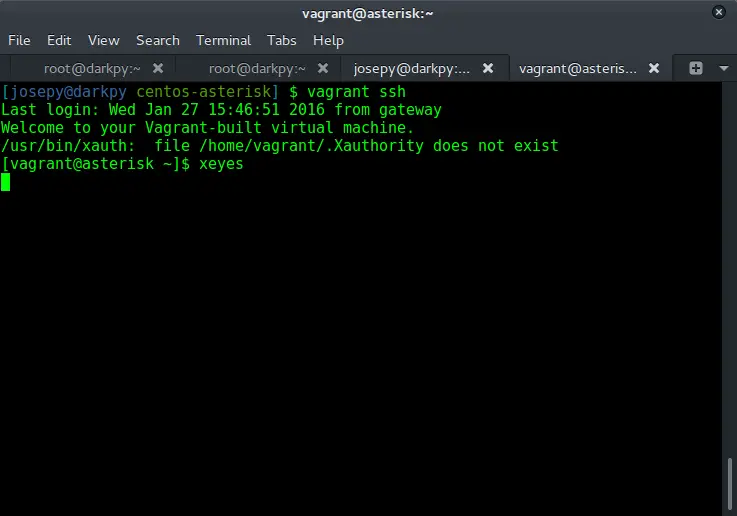
- #CENTOS 7 MINIMAL X11 FORWARDING HOW TO#
- #CENTOS 7 MINIMAL X11 FORWARDING INSTALL#
- #CENTOS 7 MINIMAL X11 FORWARDING DRIVERS#
- #CENTOS 7 MINIMAL X11 FORWARDING UPDATE#
- #CENTOS 7 MINIMAL X11 FORWARDING DRIVER#
Sep 30 22:04:44 localhost.localdomain systemd: Starting Remote desktop service (VNC). Main PID: 3766 (code=exited, status=0/SUCCESS) Process: 3761 ExecStartPre=/bin/sh -c /usr/bin/vncserver -kill %i > /dev/null 2>&1 || : (code=exited, status=0/SUCCESS) Process: 3766 ExecStart=/usr/sbin/runuser -l slax -c /usr/bin/vncserver %i (code=exited, status=0/SUCCESS) Loaded: loaded enabled vendor preset: disabled)Īctive: active (exited) since Wed 22:04:47 CEST 7s ago Now enable autostart service and restart it: $ systemctl enable systemctl restart can check the vnc service status by typing: $ systemctl status everything went ok, you should have similar terminal output to this: $ systemctl status - Remote desktop service (VNC) Would you like to enter a view-only password (y/n)? n Now we must run vncpasswd command to setup our access password, and/or view-only password (a password that allows the user to only view the remote screen): # vncpasswd This is the configuration we used for this tutorial. NOTE: You must change the USERNAME in the above config if you'll use the same VNC setup. # Clean any existing files in /tmp/.X11-unix environmentĮxecStartPre=/bin/sh -c '/usr/bin/vncserver -kill %i > /dev/null 2>&1 || :'ĮxecStart=/usr/sbin/runuser -l USERNAME -c "/usr/bin/vncserver %i"ĮxecStop=/usr/sbin/runuser USERNAME -c '/usr/bin/vncserver -kill %i' Let's copy example config and edit it: # cp vi of config:
#CENTOS 7 MINIMAL X11 FORWARDING INSTALL#
TigerVNC - is a high-performance, platform-neutral implementation of VNC # yum install -y tigervnc-server x11vnc -reopen -forever -rfbauth ~/.vnc/passwd & 2) TigerVNC server After reboot just ssh again and do it again. That's all! Now you have access to your desktop. If it is ok, simply try to connect to it using vncviewer. You can check if servers started: # netstat -an | grep 5900 We are now ready to start server: # x11vnc -reopen -forever -rfbauth ~/.vncpasswd & Write password to /root/.vnc/passwd? /n y Then we will protect server with password: # x11vnc -storepasswd This command will install server and solve all dependencies: # yum -y install x11vnc You need to enable EPEL (Extra Packages for Enterprise Linux) repository. VNC stands for Virtual Network Computing) is a very useful network graphics protocol. X11vnc – simplest of these three methods to get remote access. # yum groupinstall 'GNOME Desktop Environment' 'X Window System' 1) VNC Before we start, you need to install desktop environment to your server. All commands will work on every CentOS server 5/6/7/8. You will need to login as the root user or user with the sudo privileges.
#CENTOS 7 MINIMAL X11 FORWARDING HOW TO#
Of course in this reference manual, I will tell you how to configure this securely, so only you can access your server.īefore we begin, you will need SSH access to your server and permissions to install the software. So you need to run a server-side app on your remote machine and after that, you will be able to connect to it from all over the world. All these apps work in client-server mode.

#CENTOS 7 MINIMAL X11 FORWARDING DRIVERS#

#CENTOS 7 MINIMAL X11 FORWARDING DRIVER#
#CENTOS 7 MINIMAL X11 FORWARDING UPDATE#

Regardless of which version you’re running, we’ll show you the proper commands so you can update your system. Previous to Centos 8, yum was the package manager used. The latest version of Centos has moved to the dnf package manager. The process for upgrading a CentOS system is a little different depending on which version you have installed. Both methods will be shown in this guide, so you can pick whichever is easier for you.

This can be done via command line and GUI. In this article, we’ll cover updating a CentOS system on a per package basis and upgrading the entire operating system. Every few years, there’s a new version of CentOS released, which requires a more involved update process to install. Updating the system usually involves simply upgrading all installed packages to their latest versions. Like all Linux distros, it’s important to keep your CentOS system up to date in order to make sure that you have the latest security updates and newest features.


 0 kommentar(er)
0 kommentar(er)
